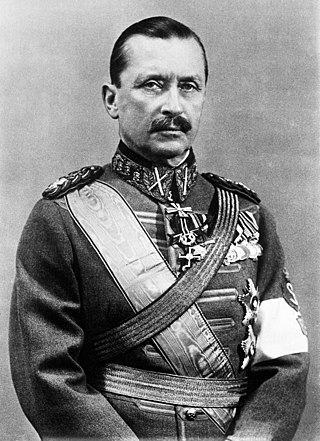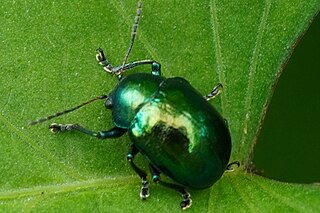
Baron Carl Gustaf Emil Mannerheim was a Finnish military commander, aristocrat, and statesman. He served as the military leader of the Whites in the Finnish Civil War (1918), as Regent of Finland (1918–1919), as commander-in-chief of the Finnish Defence Forces during the period of World War II (1939–1945), and as the sixth president of Finland (1944–1946). He became Finland's only field marshal in 1933 and was appointed honorary Marshal of Finland in 1942.
The Mannerheim Cross, officially Mannerheim Cross of the Cross of Liberty is the most distinguished Finnish military honour. A total of 191 people received the cross between 22 July 1941 and 7 May 1945, with six of the recipients receiving a cross twice. Available in two classes, the 1st class medal has only been awarded twice, with both recipients also having received the medal in the 2nd class. Although still active de jure, no crosses have been awarded since 1945. Tuomas Gerdt, the last living Knight of the Mannerheim Cross, died on 1 November 2020.

The Mannerheim Line was a defensive fortification line on the Karelian Isthmus built by Finland against the Soviet Union. While this was never an officially designated name, during the Winter War it became known as the Mannerheim Line, after Finnish Army's then commander-in-chief Field Marshal Baron Carl Gustaf Emil Mannerheim. The line was constructed in two phases: 1920–1924 and 1932–1939. By November 1939, when the Winter War began, the line was by no means complete.

Count Carl Gustaf Mannerheim was a Finnish entomologist and governor of the Viipuri province in the Grand Duchy of Finland.

Corticaria is a genus of beetles in the family Latridiidae.

The Mannerheim Museum is located in Helsinki, Finland. It is dedicated to preserving and displaying items related to the life and times of Marshal C. G. E. Mannerheim, a Finnish statesman and military officer. The Mannerheim Museum is located on top of a hill in a prestigious residential area next to the Kaivopuisto park in Helsinki. The building was the home of Mannerheim from 1924 to 1951. With the exception of a few rooms that have been converted for exhibition purposes, his home has been preserved in its original state.

Bilyaxia is a genus of beetles in the family Buprestidae, containing the following species:

Opsilia is a genus of beetles in the family Cerambycidae. It is listed as a subgenus of Phytoecia by some sources.
Synuchus breviusculus is a species of ground beetle in the subfamily Harpalinae. It was described by Mannerheim in 1849.

The Aleocharinae are one of the largest subfamilies of rove beetles, containing over 12,000 species. Previously subject to large-scale debate whether the subfamily deserved the familial status, it is now considered one of the largest subfamilies of rove beetles.
Cyanopepla cinctipennis is a moth of the subfamily Arctiinae. It was described by Francis Walker in 1865. It is found in Colombia and Ecuador.

The Hitler and Mannerheim recording is a 1942 recording of a private conversation between German dictator Adolf Hitler, and Carl Gustaf Emil Mannerheim, Commander-in-Chief of the Finnish Defence Forces. It took place on a secret visit made to Finland by Hitler to honour Mannerheim's 75th birthday on 4 June 1942, during the Continuation War, a sub-theatre of World War II. Thor Damen, a sound engineer for the Finnish broadcaster Yleisradio (YLE) who had been assigned to record the official birthday proceedings, recorded the first eleven minutes of Hitler and Mannerheim's private conversation—without Hitler's knowledge. It is the only known recording of Hitler speaking in an unofficial tone.

Clinteria is a genus of scarab beetles in the subfamily Cetoniinae found in Asia. The genus is characterized by the scutellum fused with the pronotum.

Phytoecia is a genus of longhorn beetles of the subfamily Lamiinae,

A bronze equestrian statue of Field Marshal Gustaf Mannerheim stands in the centre of Helsinki, Finland. It was made by Aimo Tukiainen and erected in 1960.

Phytoecia puncticollis is a species of beetle in the family Cerambycidae. It was described by Faldermann in 1837. It is known from Russia, Azerbaijan, Georgia, Iraq, Armenia, Turkey, Iran, and Turkmenistan. It feeds on Eryngium billardierei.

Phytoecia caerulea is a species of beetle in the family Cerambycidae. It was described by Scopoli in 1772, originally under the genus Leptura. It has a wide distribution in Europe.
Phytoecia malachitica is a species of beetle in the family Cerambycidae. It was described by Hippolyte Lucas in 1849. It is known from Portugal, Sicily, Algeria, Spain, Morocco, and Tunisia. It feeds on Cerinthe major, Cerinthe gymnandra, Echium italicum, Cynoglossum cheirifolium, Cynoglossum creticum, and Cynoglossum clandestinum.

Colasposoma dauricum is a species of leaf beetle from eastern Asia. It was first described by Carl Gustaf Mannerheim in 1849. It is known as a pest of sweet potatoes.

Mannerheim League for Child Welfare is a Finnish non-governmental organization founded in 1920 that promotes the well-being of children, young people and families with children. MLL's goal is a child-friendly Finland. It can be attributed to the construction of a comprehensive counseling system in Finland.















